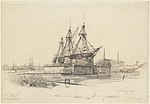Atatürk residential area

The Atatürk residential area (Dutch: Woonoord Atatürk; Turkish: Atatürk Yurdu) was a living space for Turkish guest workers in Amsterdam-Noord named after Mustafa Kemal Atatürk. It was opened in 1965 and initially housed construction workers. Until 1967, the complex was not completely full due to the construction sector not growing as expected. This led to Nederlandsche Dok en Scheepsbouw Maatschappij employees also being moved there. In 1972, tension broke out between residents and complex staff after a Turkish chef was fired and the remaining chefs only cooked Dutch food, which ended with a new Turkish chef being hired. During the final years of the complex, workers started to bring their families to the Netherlands and left Atatürk for a permanent residence elsewhere. The complex was closed in 1978 due to cost issues and the buildings were demolished. A monument commemorating Atatürk has been erected in the place where the site used to be.
Excerpt from the Wikipedia article Atatürk residential area (License: CC BY-SA 3.0, Authors, Images).Atatürk residential area
Atatürk, Amsterdam Noord
Geographical coordinates (GPS) Address Nearby Places Show on map
Geographical coordinates (GPS)
| Latitude | Longitude |
|---|---|
| N 52.403055555556 ° | E 4.8980555555556 ° |
Address
Atatürk
Atatürk
1033 DH Amsterdam, Noord
North Holland, Netherlands
Open on Google Maps








